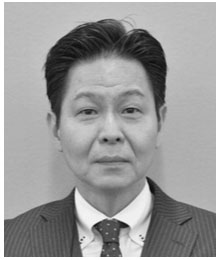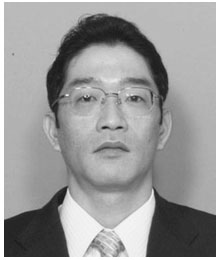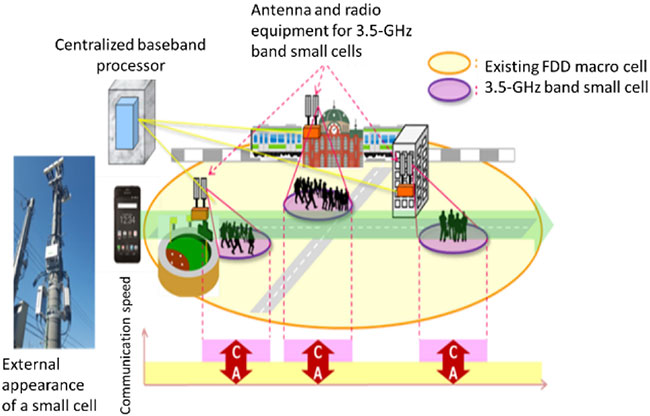There is a need to efficiently deploy the 3.5 GHz frequency band, which was newly assigned in December 2014 for TD-LTE service, in order to meet the demand for mobile communication traffic that continues to grow year on year. The 3.5 GHz band has a wider bandwidth and can effectively achieve high-speed, high-capacity downlink transmission when an increased number of slots are allocated to the downlink. This band is especially useful in enhancing the capacity per unit area when deployed for small cells. However, the 3.5 GHz band has a larger propagation loss compared to the existing lower frequency bands used for mobile communications and raises capital investment issues when it has to achieve the same wide area coverage as the existing frequency bands. Therefore, it has been necessary to devise a new method that makes deployment of the 3.5 GHz band more efficient and effective.
The award winners found a solution for the above-mentioned challenge, taking advantage of the features of Advanced C-RAN (Centralized Radio Access Network), a new network architecture commercially introduced in 2015. As shown in Figure 1, this architecture deploys 3.5 GHz band cells in combination with an existing FDD band, making use of the FDD band on the uplink to provide the capability to avoid shrinkage of service area, a challenge for the 3.5 GHz band TDD attributable to the link budget of the uplink. This solution also solves the problem of lower throughputs on the uplink by using the FDD band even when the uplink slot ratio is low. In addition, CA (Carrier Aggregation) of the existing FDD and 3.5 GHz TDD bands on the downlink achieves high-speed, high-capacity communications. Furthermore, as it is possible to maintain connectivity in the macro cell area using the existing FDD, this solution enables high-speed communication services with stable quality by preventing handovers among the macro cell area and 3.5 GHz band small cell areas that would occur due to the mobility of users.
The award winners have made remarkable contributions to the completion of 3GPP standard specifications for the 3.5 GHz band and FDD-TDD CA. They have contributed numerous technical proposals, such as one on the method of feedback signal transmission, that have been adopted as standards, facilitating accelerated development of standards. As this is the first time that the 3.5 GHz band has been used for mobile communications, the RF devices (high frequency filters) in existing mobile terminals have not yet been able to support this band. In the face of this problem, the award winners have worked to identify a filter technology for the 3.5 GHz band that is optimal from practical standpoints such as cost, size and commercialization timeline. The specifications of radio characteristics they proposed assuming use of the filter technology have been developed into standards. As described above, the award winners have made major contributions to early completion of standard specifications for 3.5 GHz TD-LTE as a whole.
The award winners also made solid contributions to commercial deployment of the first LTE-Advanced service in Japan (in June 2016), which provides high-speed communications with a maximum downlink speed of 370 Mbps based on FDD-TDD CA, taking advantage of TD-LTE on the 3.5 GHz band. The service area was expanded to 104 cities across Japan, including government-designated cities as at the end of December 2016 and is to be further extended to about 160 cities by the end of March 2017, stimulating use of rich content through mobile networks and leading to the creation and growth of new markets. As described above, the award winners have made significant contributions to the mobile communications community. The outstanding achievements of the award winners make them highly deserving of the IEICE Achievement Award.
Fig. 1 Example of 3.5 GHz TD-LTE network configuration taking advantage of Advanced C-RAN architecture
References
- Yoshida, Yoshihara, Kawai, Ihara, Takiguchi, and Yagyu, gSystem Capacity Improvement by Application of Small Cell Antenna Vertical Tilt,h IEICE Technical Report, A-P, Antenna/Propagation, June 2014.
- Atarashi, Umeda, and Abeta, gNTT DOCOMOfs Efforts Concerning Technical Developments for Introducing TD-LTE in 3.5 GHz Frequency Band,h NTT DOCOMO Technical Journal, Vol.18, No.2, Oct.2016, pp4-7.
- Fujii, Suwa, Toba, and Toeda, gBase-station Equipment with the Aim of Introducing 3.5 GHz band TD-LTE,h NTT DOCOMO Technical Journal, Vol.18, No.2, Oct.2016, pp8-13.
- Yoshihara, Kawai, Yoshida, and Kawamura, gBase Station Antennas for 3.5 GHz band,h NTT DOCOMO Technical Journal, Vol.18, No.2, Oct.2016, pp 14-17.
- Yokote, Nishimura, and Sugimoto, gHigh-precision Clock-time-synchronization Network Equipment for Introduction of 3.5 GHz band TD-LTE,h NTT DOCOMO Technical Journal, Vol.18, No.2, Oct.2016, pp18-26.
- Osawa, Ohara, Ando, and Matsuura, gRouter-type Mobile Terminal for TD-LTE in 3.5 GHz band,h NTT DOCOMO Technical Journal, Vol.18, No.2, Oct.2016, pp27-31.






